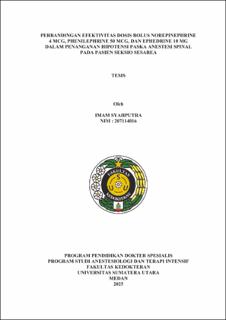Perbandingan Efektivitas Dosis Bolus Norepinephrine 4 Mcg, Phenilephrine 50 Mcg, dan Ephedrine 10 Mg dalam Penanganan Hipotensi Paska Anestesi Spinal pada Pasien Seksio Sesarea
Comparison of Effectiveness of Bolus Doses of Norepinephrine 4 Mcg, Phenilephrine 50 Mcg, and Ephedrine 10 Mg in Handling Hypotension Post-Spinal Anesthesia in Patients With Caesarean Section

Date
2025Author
Syahputra, Imam
Advisor(s)
Hamdi, Tasrif
Nadeak, Rommy F
Metadata
Show full item recordAbstract
Background: Cesarean section (CS) is one of the most commonly performed obstetric procedures,
with spinal anesthesia being the preferred anesthetic technique. Although effective, spinal
anesthesia frequently leads to hypotension, which can adversely affect both the mother and fetus.
This condition is typically managed using vasopressors. Norepinephrine, a catecholamine, exerts
direct α1 stimulation with minimal β2 activity, resulting in intense vasoconstriction of arterial and
venous vessels. Phenylephrine is a direct-acting sympathomimetic amine that functions as an α1-
adrenergic receptor agonist, whereas ephedrine is a synthetic non-catecholamine agonist of α, β1,
and β2 receptors, with both direct and indirect mechanisms of action. However, there is currently
no clear consensus on the most effective vasopressor type and dose for treating post-spinal
hypotension.
Objective: To compare the effectiveness of bolus doses of norepinephrine 4 mcg, phenylephrine
50 mcg, and ephedrine 10 mg in managing post-spinal anesthesia hypotension in patients
undergoing cesarean section.
Methods: This randomized double-blind clinical trial was conducted at three hospitals in Medan.
A total of 69 eligible patients were divided into three intervention groups: Group N
(norepinephrine 4 mcg IV), Group P (phenylephrine 50 mcg IV), and Group E (ephedrine 10 mg
IV). Hemodynamic parameters such as systolic and diastolic blood pressure, along with side
effects, were recorded and analyzed using appropriate statistical tests.
Results: Norepinephrine 4 mcg was more effective in maintaining stable blood pressure compared
to phenylephrine and ephedrine, with minimal side effects such as bradycardia and nausea. While
phenylephrine was also effective in preventing hypotension, it frequently caused significant
bradycardia. Ephedrine, on the other hand, showed lower efficacy in blood pressure control and
was more often associated with adverse effects like tachycardia.
Conclusion: Norepinephrine 4 mcg is the most effective and safest vasopressor for managing
post-spinal hypotension in cesarean section patients, with fewer side effects compared to
phenylephrine and ephedrine.
Collections
- Master Theses [177]
